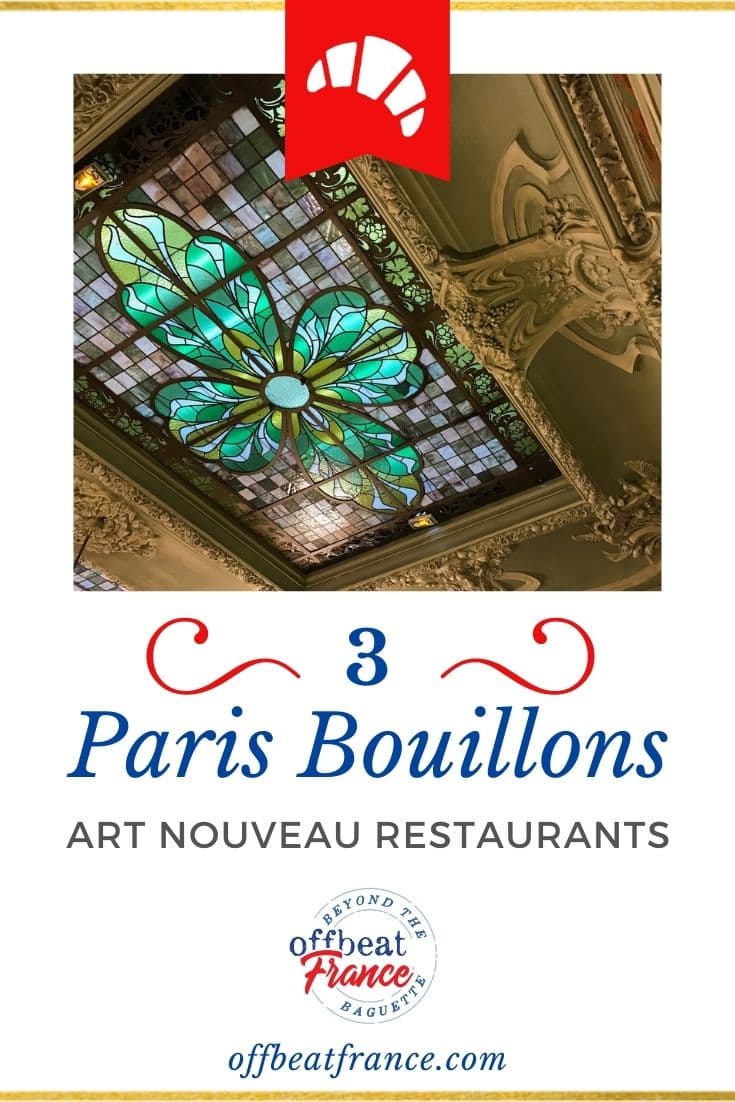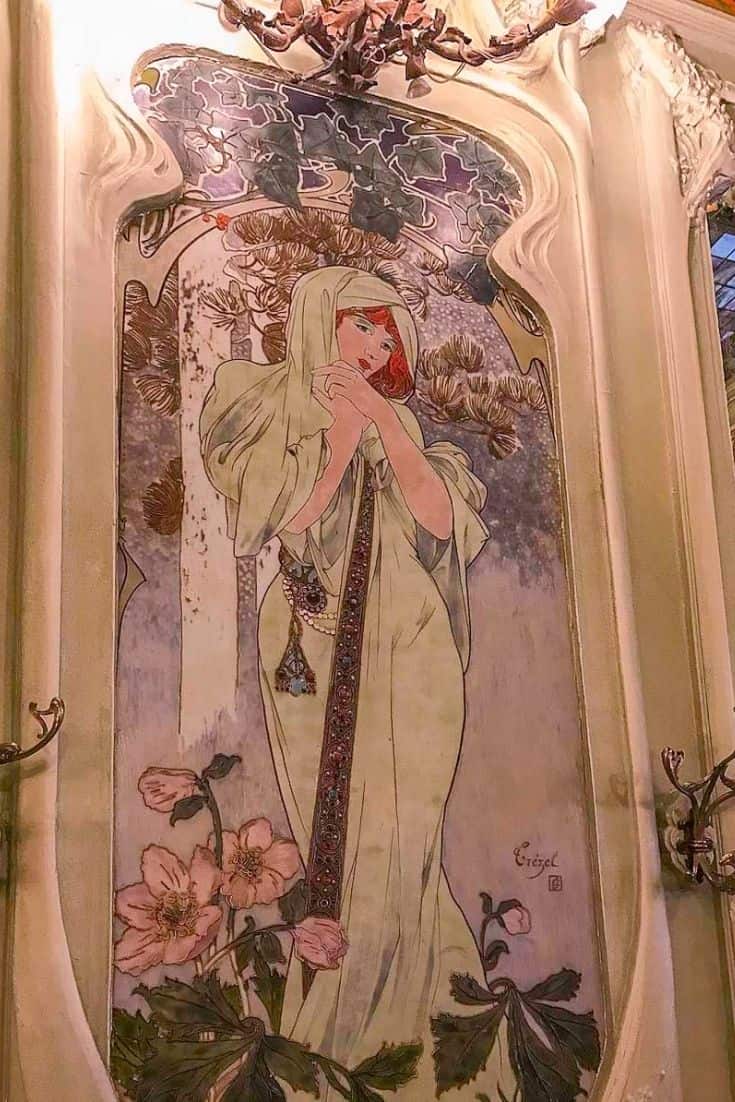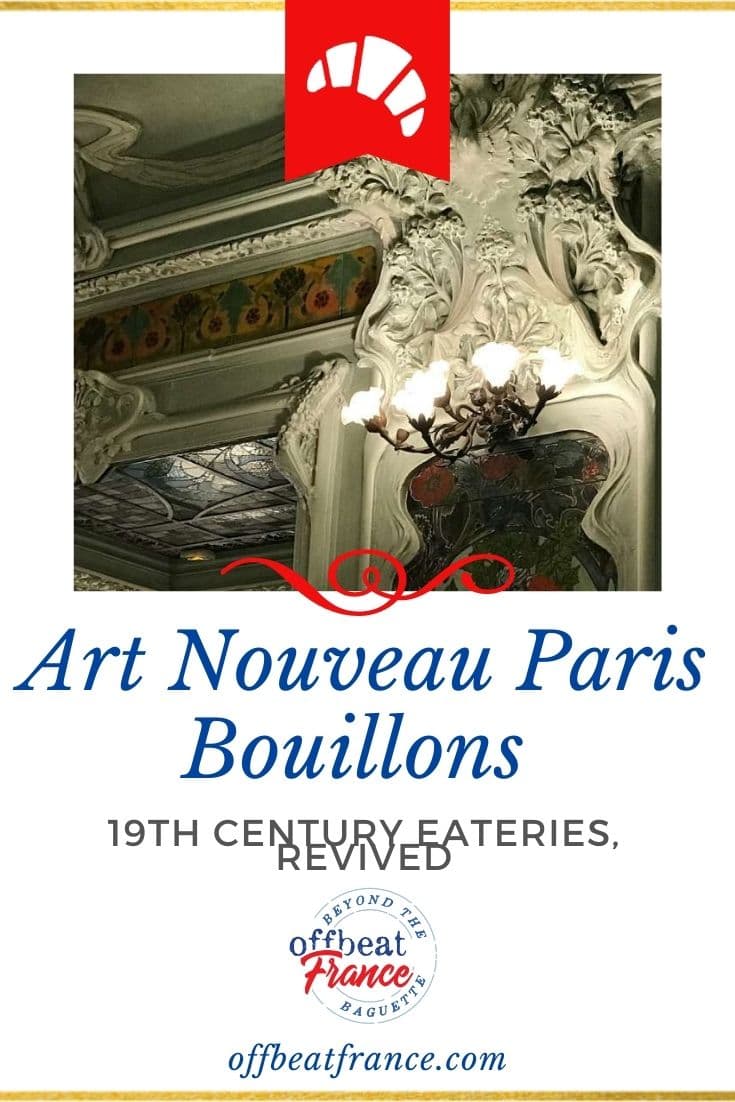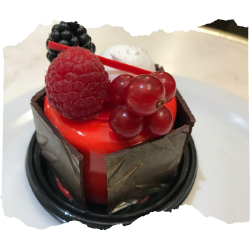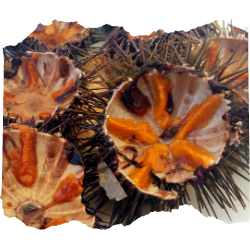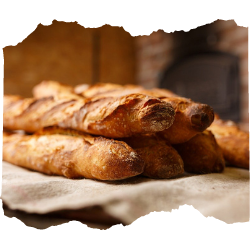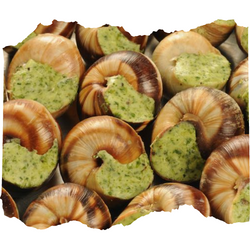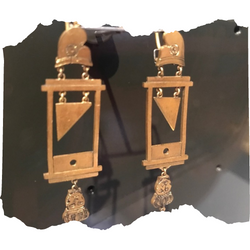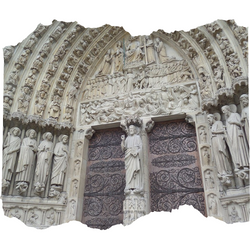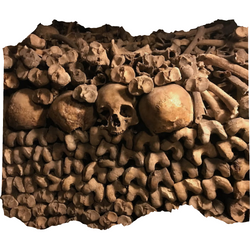Unsure about your French table manners? Click Here to download > > How to avoid these 10 food etiquette mistakes !
- Home ›
- Ze French ›
- La Gastronomie ›
- Bouillons of Paris
The Magnificent Comeback of the Paris Bouillon Restaurants
Published 02 October 2021 by Leyla Alyanak — Parisian by birth, Lyonnaise by adoption, historian by passion
I only discovered Parisian bouillon restaurants a few years ago, and I was so taken that whenever I visit Paris now, I make it a point to eat in a bouillon. Here's what I've managed so far.
Barely a century ago, finding authentic and tasty food in Paris at a reasonable price was a cinch. You could stop by one of 250 Paris bouillon restaurants, the famous eateries of the capital’s working class.
But then came wars, restaurants evolved, high-end brasseries became popular, fast food emerged as a cheap alternative, and the working classes no longer needed the special canteen-type establishments they had once loved.
And so the bouillons went into decline, and nearly died.
NOTE: Pages on this site may contain affiliate links, which support this site. See full Privacy Policy here.
The bouillon Paris restaurants might well have disappeared altogether, had it not been for two things.
In the early 2000s, a single bouillon remained in Paris: the Bouillon Chartier. New owners sought to return to the source and revive the ideal of what a bouillon should provide − good food, decent portions, low prices, and a stunning decor. Many are now listed as historic monuments.
On its heels, in 2017, the Bouillon Pigalle opened its doors, same principles but in a modern airy decor, all launched with a massive publicity campaign.
By now Parisians were willing to listen.
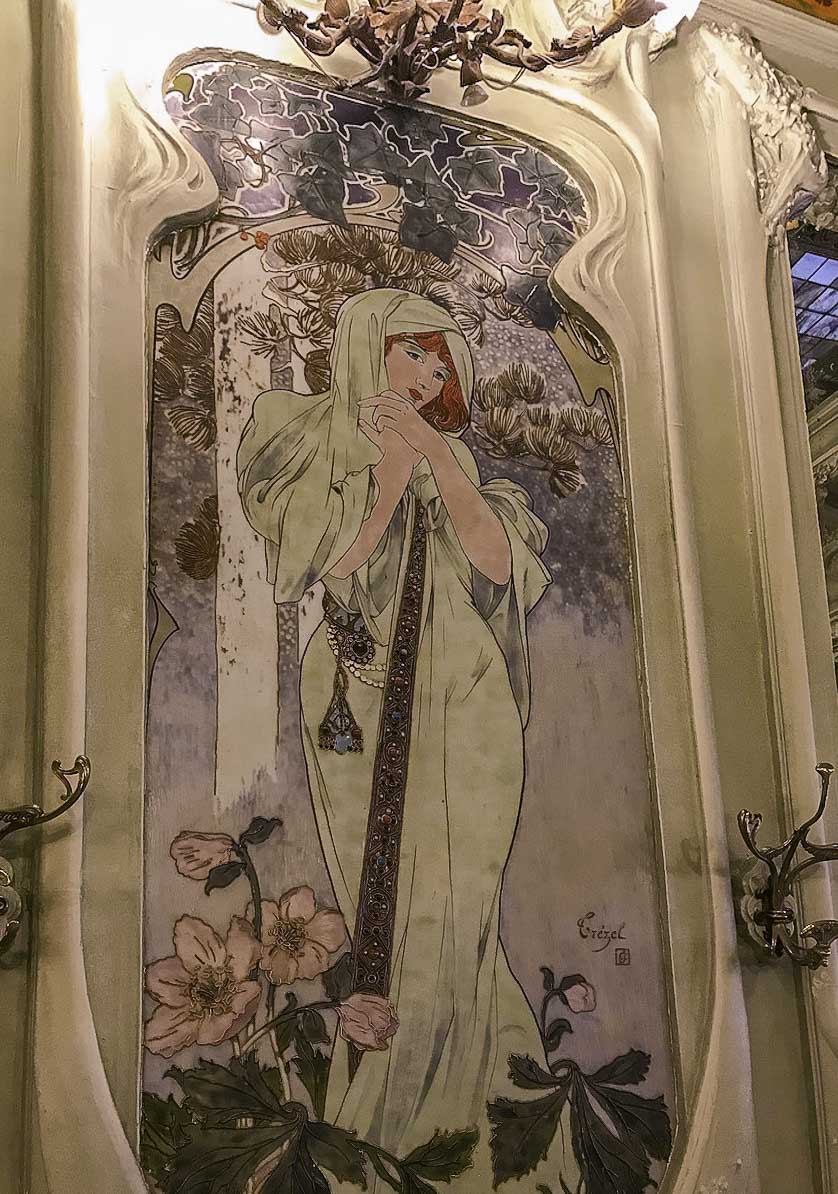 Typical decor in a Paris bouillon - here, we are at Julien
Typical decor in a Paris bouillon - here, we are at JulienCompetitors multiplied, and the venerable Paris bouillon began making a remarkable comeback. And I decided to eat my way through them.
So far, I have tested five Paris bouillon restaurants, which I detail below. But each time I go to one bouillon, another opens, so they're keeping me on my toes.
They are mostly good value for money, provide traditional and authentic cuisine, and many are "d'époque", with their original décor.
What is a bouillon restaurant?
The bouillon is to Paris what the bouchon is to Lyon or the winstub to the Alsace.
The bouillon definition, simply put, it is a large eatery where classic French dishes are served quickly and cheaply, often in magnificent surroundings.
The bouillon is the quintessential fast food joint of the Belle Epoque, from the beginning of the 20th century until the start of World War I.
(And in case you’re wondering about bouillon pronunciation, let me try to help: BOO-yawn − but try not to pronounce the “n” at the end of yawn.)
The Paris bouillon and Belle Époque dining
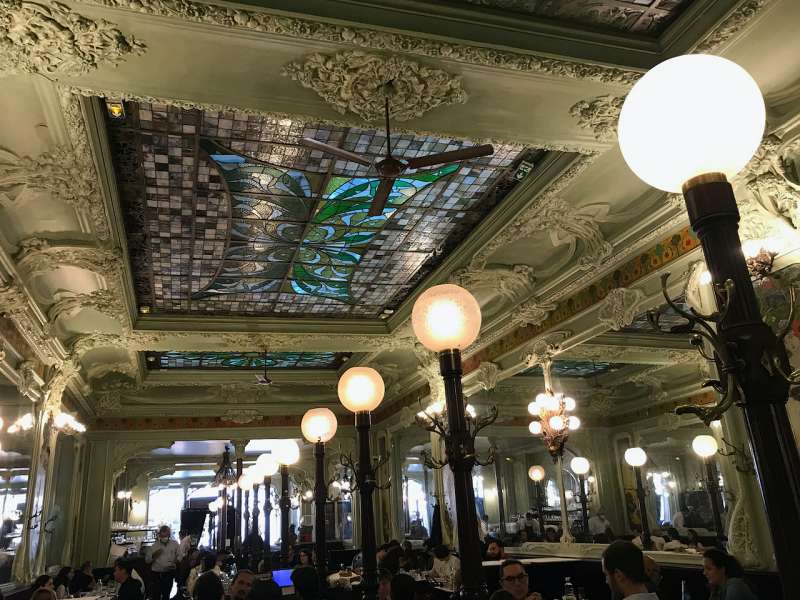 The quintessential bouillon restaurant Paris: Le Bouillon Julien
The quintessential bouillon restaurant Paris: Le Bouillon JulienIt all started in 1855 with a Parisian butcher by the name of Pierre-Louis Duval, who supplied some of the top bourgeois homes of Paris and, it is said, the kitchens of the Tuileries Palace, then the imperial residence of Emperor Napoleon III and his wife Empress Eugénie.
(The Tuileries were set on fire by Communard revolutionaries in 1871, almost burning down the adjacent Louvre in its wake; despite calls for its restoration, the Tuileries was eventually razed a decade after the fire.)
But back to our butcher.
His clientele being high and mighty, Duval was often left with lesser cuts of meat on his hands. To limit waste and increase his profits, he decided to use these ‘leftovers’ in an ingenious way: he opened a canteen for workers of Les Halles nearby, back when the city’s major food market was still in the heart of the city (it was moved to the suburbs in 1969).
Here, he served a simple dish typical of northern France, the hochepot de boeuf, boiled beef in its bouillon stock (hence the name of these restaurants), with a few uncomplicated vegetables.
A pot would boil all day, every day, allowing the workers to eat their fill at a price even they could afford. And the food was tasty!
Market hands gathered around a hot midday meal, a moment of respite during which they could forget their backbreaking work and chat with their colleagues. This would be the original bouillon.
The notion caught on and Duval opened more bouillons, building what was in effect France’s first chain of restaurants.
Competition existed then too, and soon, bouillons were popping up all over Paris.
Dishes were added to menus, decors were spruced up, and soon, well-off Parisians joined the city’s workers in frequenting these establishments, bringing their number to some 250 by the end of the century.
It would take another 100 years for them to stage their comeback.
You might also like these stories!
The bouillon experience
Each Paris bouillon has its own personality, but there will usually be some common threads.
First, the food should be authentic, mostly traditional fare, with few bells and whistles: you’ll find such mainstays as poireaux vinaigrette (leeks in vinaigrette) or braised meats or simple desserts, like rice pudding (riz au lait) or crème caramel. Nothing fancy.
The food might be no different from the bouillon Paris menu of the 1800s, the kind of food Napoleon III might well have eaten had he wandered into a bouillon (which, I can quite safely say, never happened).
If you’re French, you may recognize many of the dishes as versions of what your grandmother conjured up in your youth.
Second, the prices will be reasonable, and you might even be able to get away with a meal for under €20, depending on where you go and what you order.
Third, eating in a bouillon should be an experience. The ambiance sizzles, with waiters balancing multiple trays on arms that seem endless.
Bouillons are crowded, several do not take reservations and you’ll be standing in line outside, along with Parisians and tourists.
Inside, if you happen to be on your own, don’t be surprised if you’re escorted to an occupied table and directed to the lone, empty chair. All part of the experience.
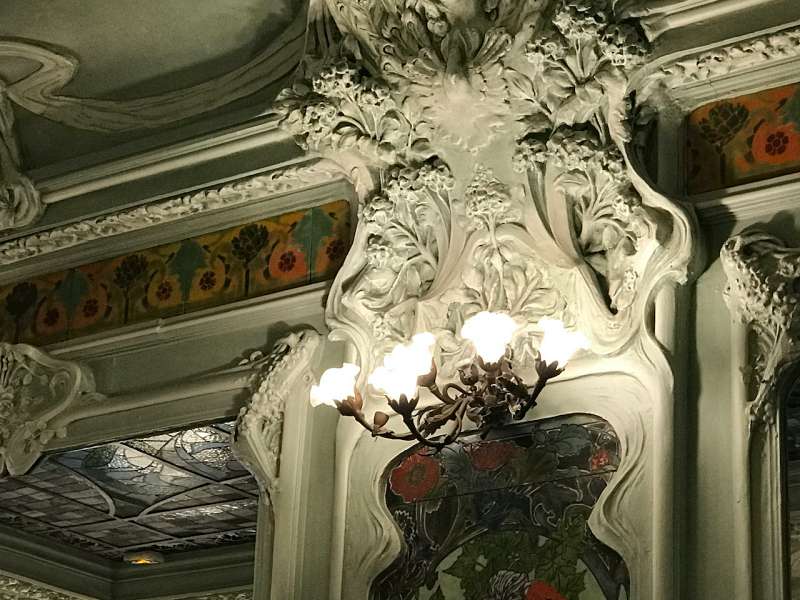 A typical bouillon Paris restaurant decor
A typical bouillon Paris restaurant decorFourth, a historical bouillon will have an unmistakable Belle Epoque décor, filled with Art Nouveau decor, woodwork and glass ceilings, with original floor tiles. Typically, you’ll enter into a modest-sized room with a large bar on the side. Beyond, a larger room will open up, usually topped with a glass ceiling canopy.
The best bouillons in Paris
They may not be in the Guide Michelin, but the bouillons of Paris should be on any discerning list of things to do, especially if you're hoping to experience the offbeat side of Paris.
It's impossible to choose the best: I've had lousy dining experiences in places others love, and I've had brilliant meals where others report an average ho-hum.
The only way to be sure is to go out and undertake some scientific research yourself.
So far, I have taken on the challenging task of field-testing five of the best Paris bouillons for you. Here's what my research revealed.
1. Bouillon Restaurant Julien
Tucked away among the Turkish kebab joints of this working class part of town, the Julien is an Art Nouveau gem with a hefty history behind it. It opened in 1903 and its woodwork was designed in by none other than Louis Majorelle, the famous Nancy School Art Nouveau furniture designer.
It was also a favourite of singer Edith Piaf (Table 24, apparently), and one of the locations for La Môme, the Marion Cotillard film retracing Piaf’s life. It also happens to be one of those bouillons classified as a historical monument.
The Bouillon Julien has a slogan: “Beau, bon, pas cher.” Attractive, tasty, inexpensive.
And it lived up to the promise.
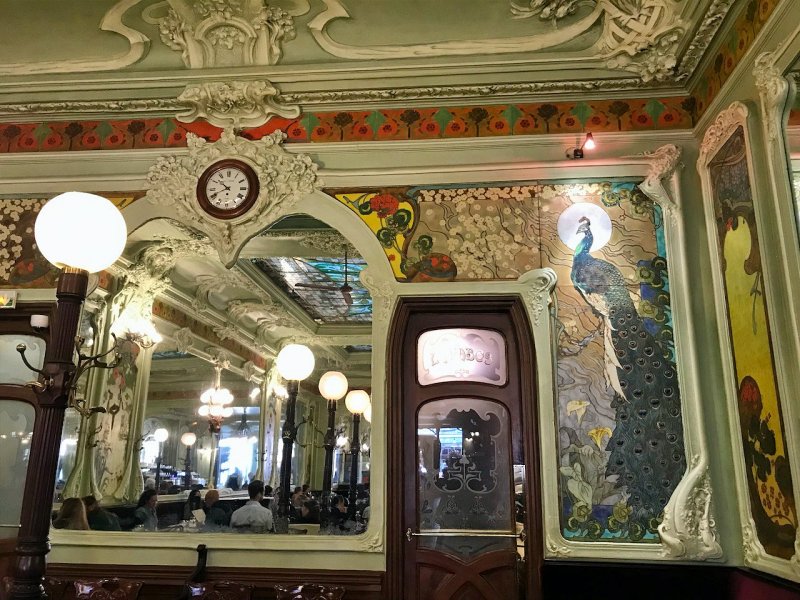
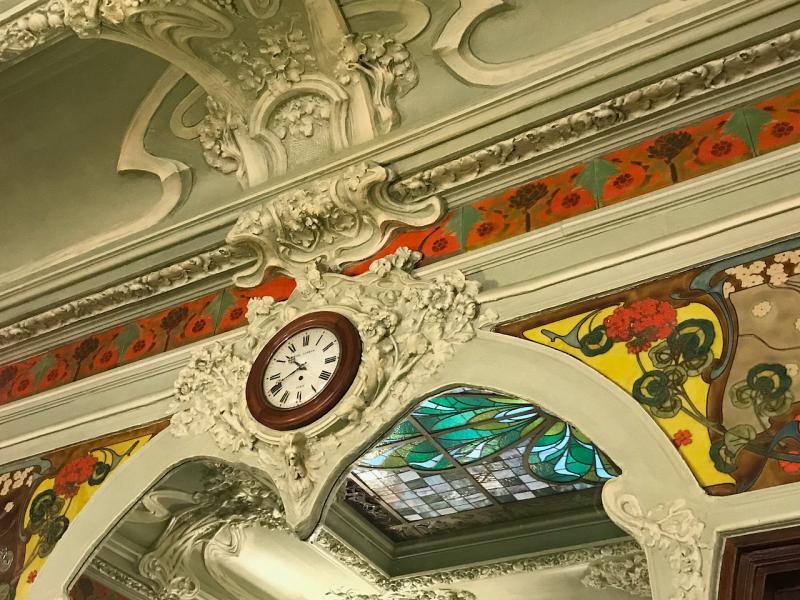
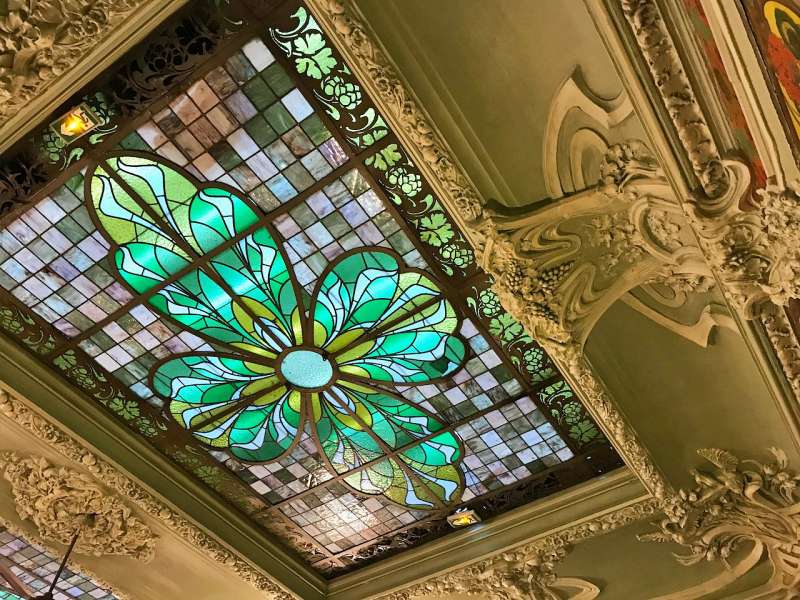
This was another memorable meal, memorable for its simplicity: a starter of escargots, perfectly buttery and seasoned, followed by a traditional sausage and mashed potatoes, a delicious pork sausage, not too strong and beautifully fragrant.
Dessert? A chestnut mousse and meringue.
I did pay nearly €30, but the escargots and dessert were expensive and, well, who can resist?
You’d be forgiven if your eyes wandered from your plate towards the stained glass ceiling, put together by Louis Trezel, the brilliant Art Nouveau glass designer responsible for several of the fabulous bouillon ceilings still in existence.
Bouillon Julien, 16 rue du Faubourg Saint-Denis, Paris 10
2. Bouillon Pigalle
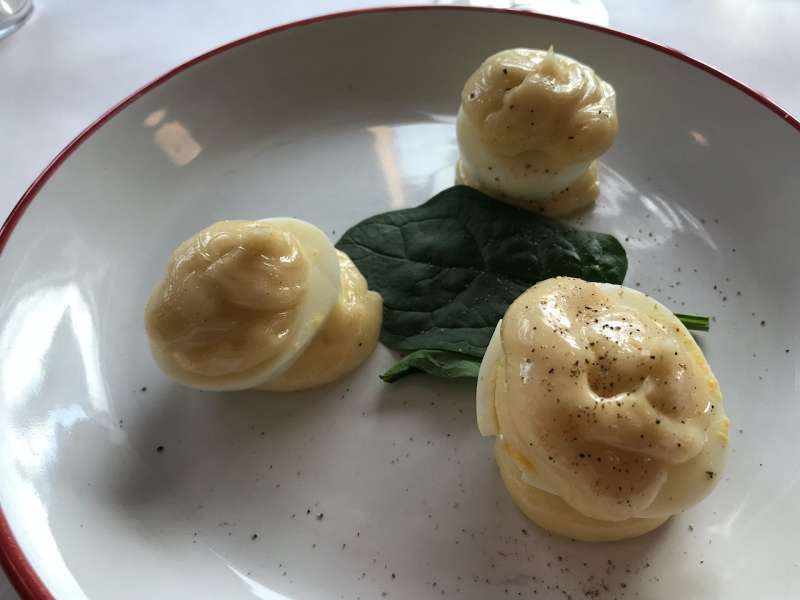
This is the new kid on the block, the one opened in 2017. It also happens to be largely responsible for the renewed interest in this type of restaurant. It may be modern and warmly sleek with its red banquettes and wooden chairs but the emphasis on traditional fare and low prices has made it the talk of Paris.
My meal at Pigalle was so simple I might have been in a school canteen.
I started with eggs mayonnaise, les "oeufs mayonnaise", not because I like them but because these particular eggs won the Best Egg Mayonnaise Award from the Association for the Protection of the Egg Mayonnaise, two years in a row. The fact that there IS such a contest, let alone that they won it, was enough to make me curious.
The eggs lived up to their reputation, but I wouldn’t realize this until later.
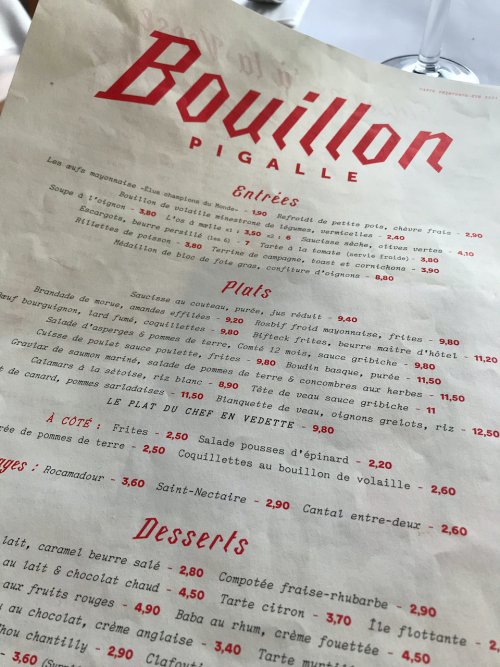
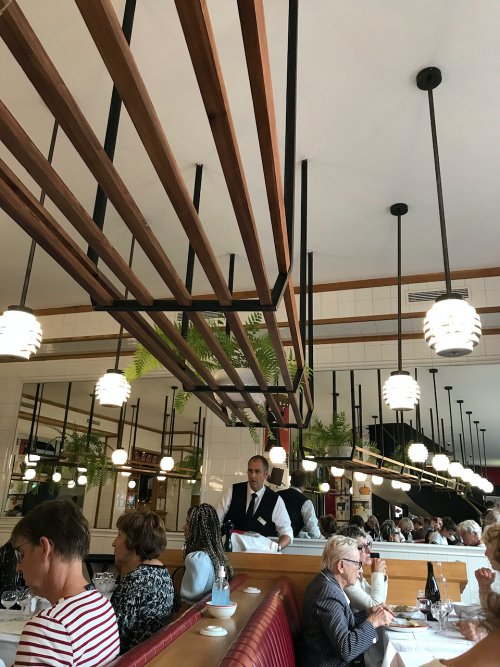
Next was the day’s special, braised veal with mashed potatoes, basic but delightful, with just enough sauce and perfect seasoning.
For dessert, who can resist an Île Flottante, or floating island, a cloud of meringue floating on a bed of creamy custard?
All in all this was an outstanding experience, from the warm welcome to the price on the bill: €15.80, at dinnertime no less. It's also in an interesting neighbourhood... near the Moulin Rouge and smack in the middle of the sex shop district.
No worries, though, it's all pretty tame – I just wouldn't walk around on my own late at night.
Pigalle is so popular it has birthed a little brother, the Bouillon République, which is also getting rave reviews. Another time.
Bouillon Pigalle, 22 Bd de Clichy, Paris 18
3. Bouillon Chartier Restaurant
This is a classic, where people come as much to eat as to experience the waiter scribbling your order on the paper tablecloth rather than on a pad.
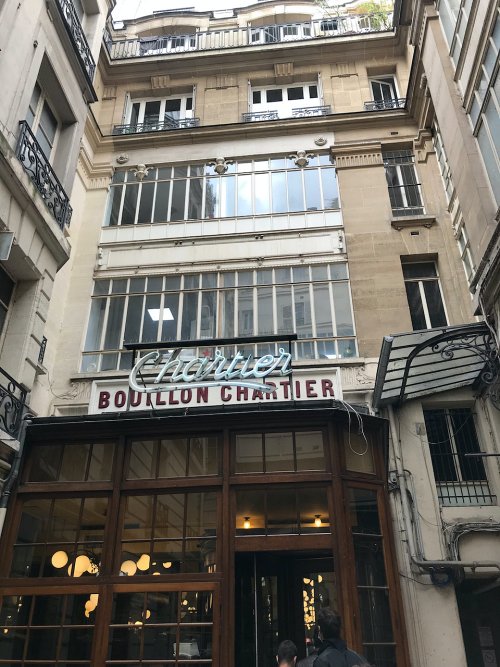
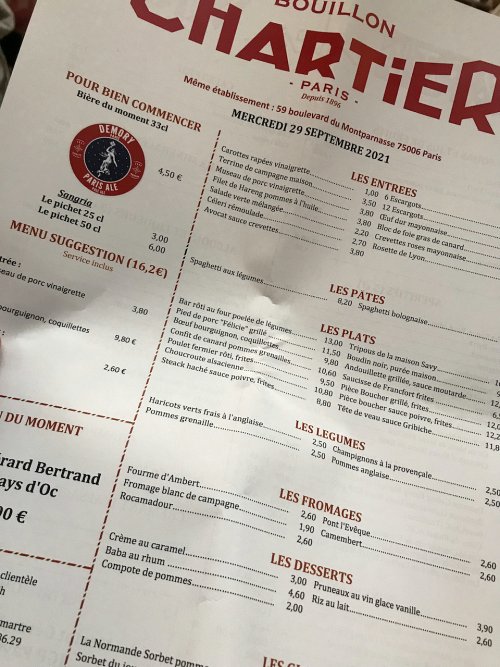
First opened in 1896, just in time for the Universal Exhibition of 1900, this Paris institution is impressive, authentic, and is the only true survivor of that first wave of bouillons inaugurated in the late 19th century.
Service may be a bit more brisk than elsewhere, but perhaps that is because the staff lives off tips and a percentage of the profits. It’s definitely not a place to dawdle… but the bustle is also part of its charm, as is the long line that moves (quite quickly) at the front door. The waiters look as though they’ve jumped out of a history book, with their black vests and bow ties.
While the decor was as authentic as you could wish, the food that day did not live up to my expectations. In the spirit of comparative research, I started with eggs mayonnaise. The mayonnaise was more mustardy than that of the Pigalle eggs, almost too much so, and definitely more salty.
For my main dish I ordered a confit of duck, which I’d read was a specialty.
Rather than the moist, fall-off-the-bone delicacy I should have been served, the duck was dry, stringy and in some places so brittle I felt I might be eating bits of bone. Very disappointing.
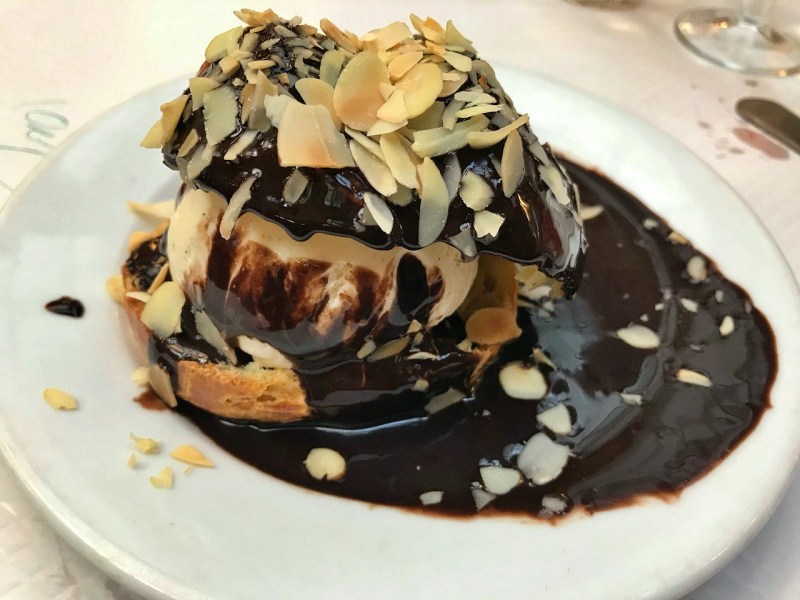
But things started looking up when dessert arrived, the Chartier Profiterole, a giant choux pastry filled with ice cream and slathered in chocolate sauce. It absolutely made up for everything else.
Also, given that it has received many positive reviews over the years, I’m often willing to give establishments a second chance, especially given the decor and its status as a historical monument. I'll be back.
Bouillon Chartier, 7 rue du Faubourg Montmartre, Paris 9
It also has a twin, the Bouillon Chartier Montparnasse, at 59 boulevard du Montparnasse, Paris 6
4. Bouillon Racine restaurant
The Bouillon Racine is my latest exploration and I walked away quite satisfied. Intriguingly, it was created by the Chartiers, owners of the Bouillon Chartier, back in 1906 (in fact, the name Chartier is still out front).
It changed hands a few times over the years until it eventually became the staff cafeteria of the nearby Sorbonne.
Only in the 1990s did it become a restaurant again, with a fabulous architectural restoration that guaranteed it a place on France's list of historical monuments.
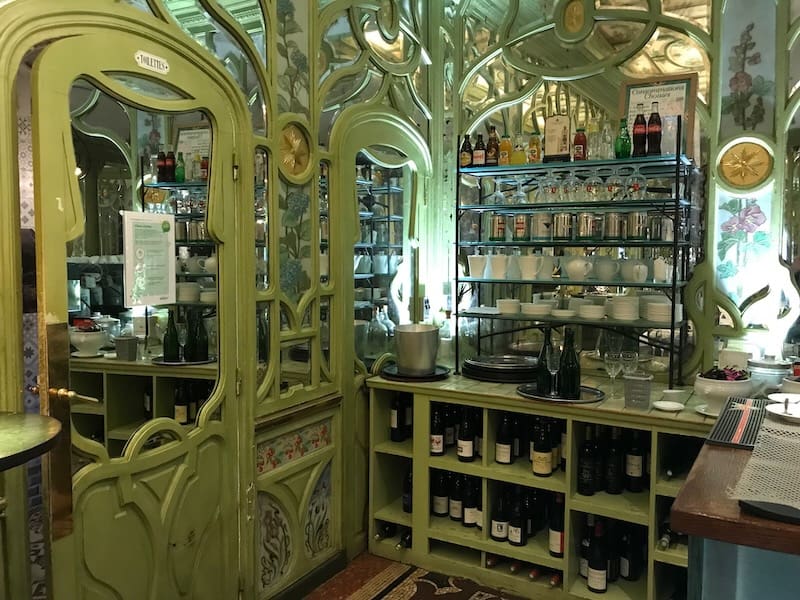 Inside the Racine Bouillon, Paris
Inside the Racine Bouillon, ParisWhat stood out for me here was the service, so friendly I might have been in an American restaurant, all smiles and helpfulness – almost disconcerting in the heart of Paris, but welcome nonetheless.
I can imagine that foreign visitors stopping by for a meal (after having reserved) would feel quite at ease here.
What really stands out here is the Belle Epoque decor, especially upstairs. If you let your eyes wander, you might well believe you're on the cusp of the 20th century, during that marvellous era of change and anticipation.
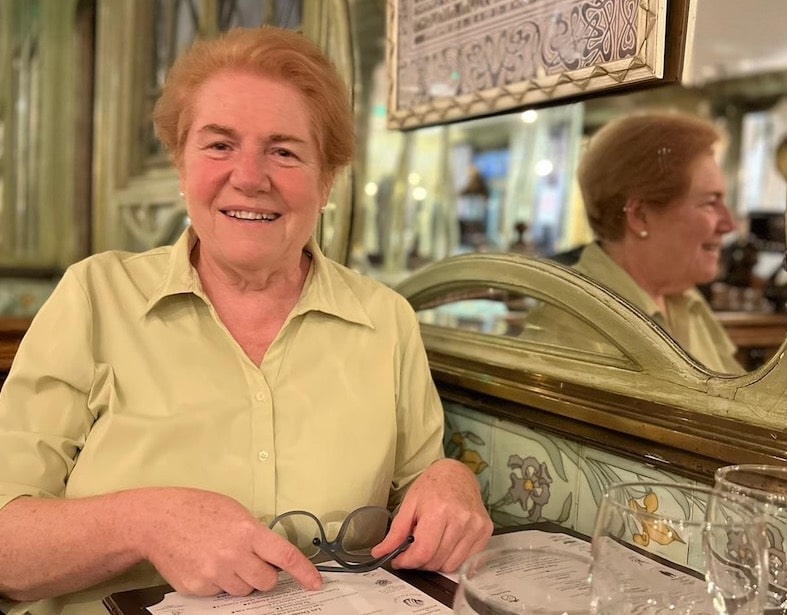
The food was lovely, not sublime, but well above average. My moist pork ribs did not disappoint, and I was truly sorry to mop up the last crumbs of my mango Pavlova. While large, it was so good it could have been twice the size and made me twice as happy. I was pleased enough to know I'll definitely be back.
Bouillon Racine, 3 rue Racine, Paris 6
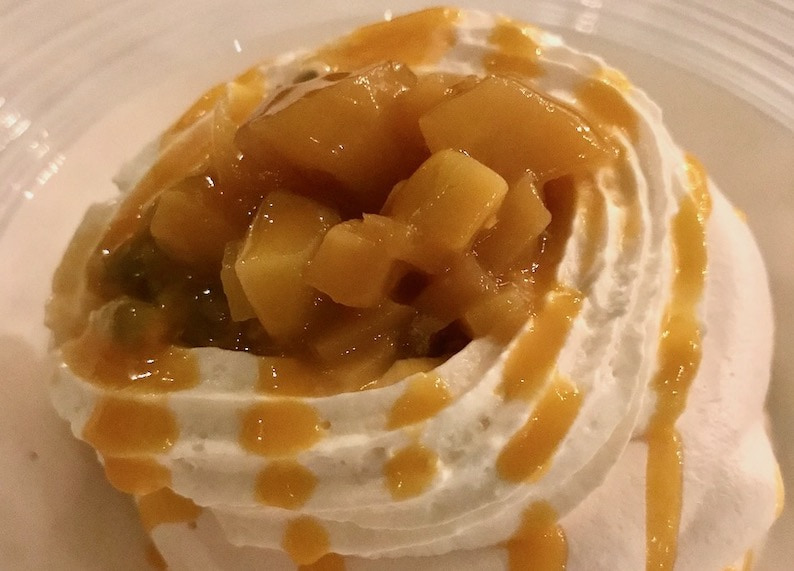
5. Le petit bouillon Pharamond
The Pharamond is another one of those long-standing bouillons with a claim to fame, snuggled in the heart of Les Halles, once the "stomach" of Paris but now a revamped and modernizing part of town.
Initially named A La Petite Normande (the name still graces the restaurant's façade), the Pharamond family set up shop here after moving to Paris from Normandy, selling traditional French cuisine at modest prices.
The menu is authentic bouillon − I started with eggs mimosa (no plain eggs mayo here!) − followed by an andouillette and, irresistibly, a profiterole, with its giant homemade chou pastry. That said, I couldn't take my eyes off my neighbour's steak tartare...
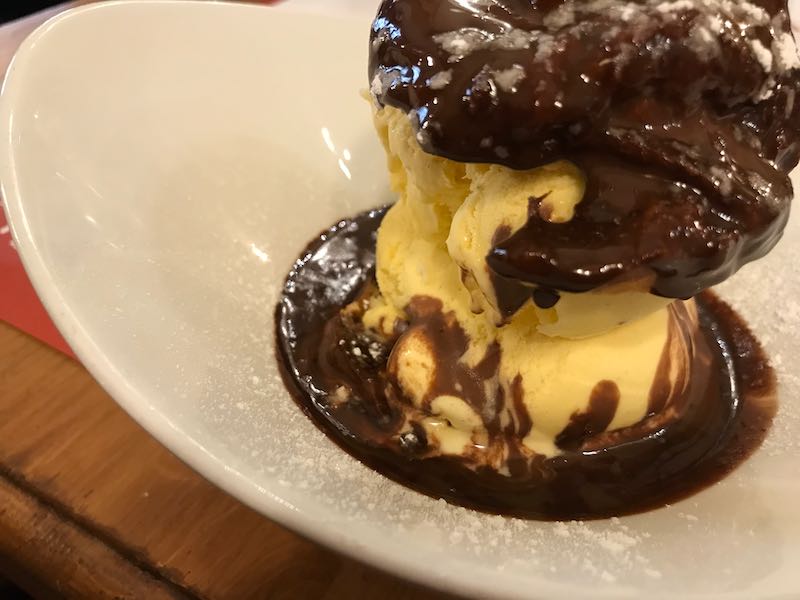 The notorious profiterole
The notorious profiterole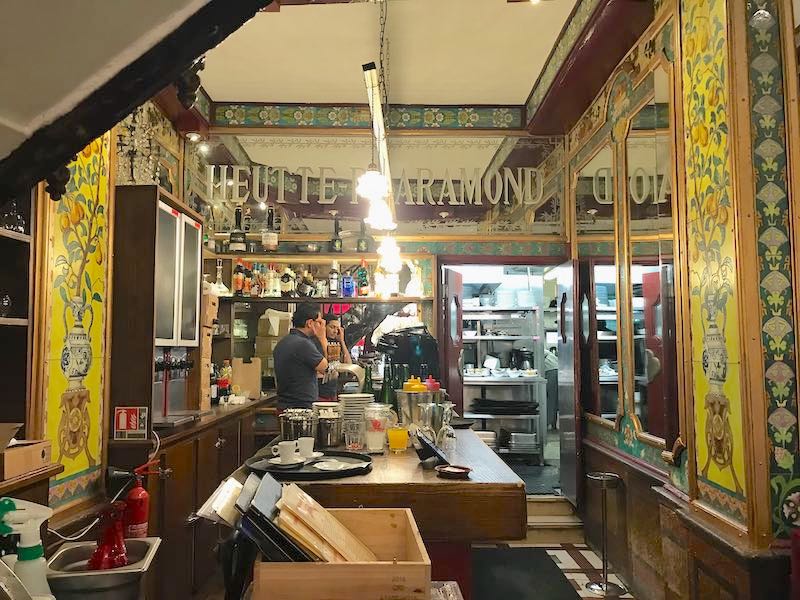
Clearly I'm not the only one who found eating here a pleasure: the likes of Ernest Hemingway, Oscar Wilde and F. Scott Fitzgerald, not to mention several French presidents and artists, also apparently graced the bouillon with their presence.
The Belle Epoque drips off every corner of this classic bouillon parisien, but a special touch is tucked away on the third floor: a set of private rooms you can rent to dine with your friends away from the crowds. A nice idea I wouldn't mind trying, but the jumble of small tables which rub elbows with one another also have their charm.
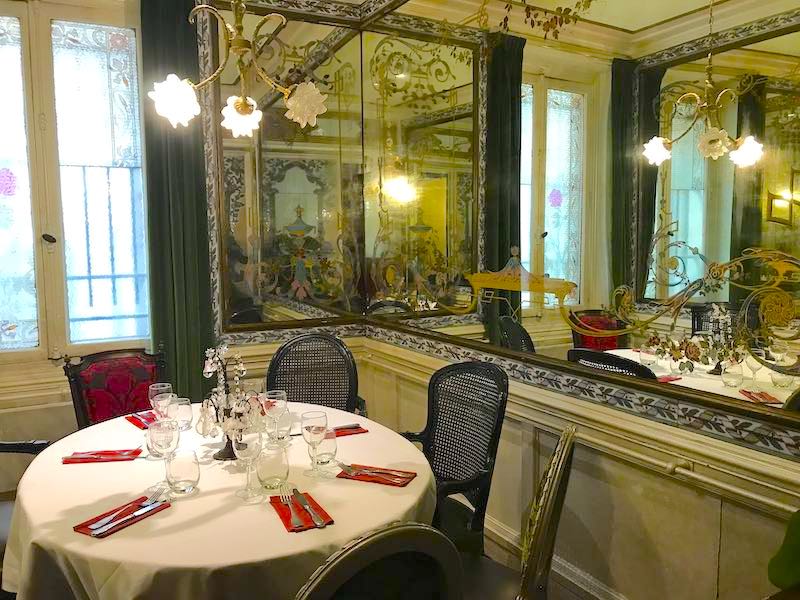 A private room at the Pharamond
A private room at the PharamondLe Petit Bouillon Pharamond, 24 Rue de la Grande Truanderie, Paris 1
I have yet to try several noteworthy bouillons: Bouillon de la République (Pigalle’s little brother) and Chartier Montparnasse (and possibly a second round of the original Chartier, in case I hit a bad day). Along with the others that will undoubtedly have opened their doors by then...
If you travel to Paris in the fall, you'll find it's an ideal time for a bouillon meal. So is Paris in winter, when it's cold outside and you need some authentic rib-sticking Parisian food in a decor that warms your heart.
—All photos ©Offbeatfrance.com
FAQ: bouillon restaurants in Paris
How many Parisian bouillon restaurants are there in Paris?
How many Parisian bouillon restaurants are there in Paris?
At the turn of the 20th century, Paris had more than 250 bouillons. They had almost disappeared by the early 21st century but then made a stunning comeback. Now, new ones are opening regularly and there are at least a dozen, if not more.
Which is the best bouillon in Paris?
Which is the best bouillon in Paris?
This is very subjective. However, there is general agreement that the list is topped, in no order, by the Petit Bouillon Pharamond, Bouillon Pigalle, Bouillon Julien and Bouillon Chartier.
What is a bouillon in Paris?
What is a bouillon in Paris?
A bouillon is a restaurant that usually services traditional fare. It got its name from a bouillon, or broth, prepared with meat from the nearby Halles market and destined for the market's staff. Bouillons gained a reputation for good food at affordable prices.
What does bouillon mean in a restaurant?
What does bouillon mean in a restaurant?
A bouillon could mean a broth, but if referring to a restaurant, it is a type of restaurant serving traditional foods in Paris.
What is a typical bouillon Paris menu?
What is a typical bouillon Paris menu?
The typical bouillon menu is traditional. You'll usually find eggs mayonnaise as a starter, and profiterolles au chocolat for dessert. For the main course, expect standard cuts of meat and meat stews, along with roast chicken.
Did you enjoy this article? I'd love if you shared it!
Pin these and save for later!
